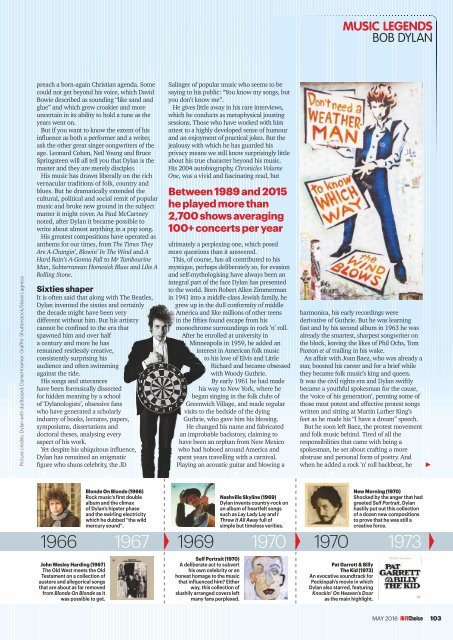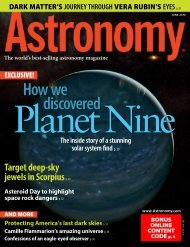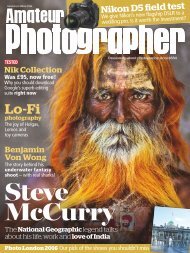You also want an ePaper? Increase the reach of your titles
YUMPU automatically turns print PDFs into web optimized ePapers that Google loves.
MUSIC LEGENDS<br />
BOB DYLAN<br />
Picture credits: Dylan with dartboard: Daniel Kramer. Graffiti: Shutterstock/Steve Lagreca<br />
preach a born-again Christian agenda. Some<br />
could not get beyond his voice, which David<br />
Bowie described as sounding “like sand and<br />
glue” and which grew croakier and more<br />
uncertain in its ability to hold a tune as the<br />
years went on.<br />
But if you want to know the extent of his<br />
influence as both a performer and a writer,<br />
ask the other great singer-songwriters of the<br />
age. Leonard Cohen, Neil Young and Bruce<br />
Springsteen will all tell you that Dylan is the<br />
master and they are merely disciples.<br />
<strong>Hi</strong>s music has drawn liberally on the rich<br />
vernacular traditions of folk, country and<br />
blues. But he dramatically extended the<br />
cultural, political and social remit of popular<br />
music and broke new ground in the subject<br />
matter it might cover. As Paul McCartney<br />
noted, after Dylan it became possible to<br />
write about almost anything in a pop song.<br />
<strong>Hi</strong>s greatest compositions have operated as<br />
anthems for our times, from The Times They<br />
Are A-Changin’, Blowin’ In The Wind and A<br />
Hard Rain’s A-Gonna Fall to Mr Tambourine<br />
Man, Subterranean Homesick Blues and Like A<br />
Rolling Stone.<br />
Sixties shaper<br />
It is often said that along with The Beatles,<br />
Dylan invented the sixties and certainly<br />
the decade might have been very<br />
different without him. But his artistry<br />
cannot be confined to the era that<br />
spawned him and over half<br />
a century and more he has<br />
remained restlessly creative,<br />
consistently surprising his<br />
audience and often swimming<br />
against the tide.<br />
<strong>Hi</strong>s songs and utterances<br />
have been forensically dissected<br />
for hidden meaning by a school<br />
of ‘Dylanologists’, obsessive fans<br />
who have generated a scholarly<br />
industry of books, lectures, papers,<br />
symposiums, dissertations and<br />
doctoral theses, analysing every<br />
aspect of his work.<br />
Yet despite his ubiquitous influence,<br />
Dylan has remained an enigmatic<br />
figure who shuns celebrity, the JD<br />
Salinger of popular music who seems to be<br />
saying to his public: “You know my songs, but<br />
you don’t know me”.<br />
He gives little away in his rare interviews,<br />
which he conducts as metaphysical jousting<br />
sessions. Those who have worked with him<br />
attest to a highly developed sense of humour<br />
and an enjoyment of practical jokes. But the<br />
jealousy with which he has guarded his<br />
privacy means we still know surprisingly little<br />
about his true character beyond his music.<br />
<strong>Hi</strong>s 2004 autobiography, Chronicles Volume<br />
One, was a vivid and fascinating read, but<br />
Between 1989 and 2015<br />
he played more than<br />
2,700 shows averaging<br />
100+ concerts per year<br />
ultimately a perplexing one, which posed<br />
more questions than it answered.<br />
This, of course, has all contributed to his<br />
mystique, perhaps deliberately so, for evasion<br />
and self-mythologising have always been an<br />
integral part of the face Dylan has presented<br />
to the world. Born Robert Allen Zimmerman<br />
in 1941 into a middle-class Jewish family, he<br />
grew up in the dull conformity of middle<br />
America and like millions of other teens<br />
in the fifties found escape from his<br />
monochrome surroundings in rock ’n’ roll.<br />
After he enrolled at university in<br />
Minneapolis in 1959, he added an<br />
interest in American folk music<br />
to his love of Elvis and Little<br />
Richard and became obsessed<br />
with Woody Guthrie.<br />
By early 1961 he had made<br />
his way to New York, where he<br />
began singing in the folk clubs of<br />
Greenwich Village, and made regular<br />
visits to the bedside of the dying<br />
Guthrie, who gave him his blessing.<br />
He changed his name and fabricated<br />
an improbable backstory, claiming to<br />
have been an orphan from New Mexico<br />
who had hoboed around America and<br />
spent years travelling with a carnival.<br />
Playing an acoustic guitar and blowing a<br />
harmonica, his early recordings were<br />
derivative of Guthrie. But he was learning<br />
fast and by his second album in 1963 he was<br />
already the smartest, sharpest songwriter on<br />
the block, leaving the likes of Phil Ochs, Tom<br />
Paxton et al trailing in his wake.<br />
An affair with Joan Baez, who was already a<br />
star, boosted his career and for a brief while<br />
they became folk music’s king and queen.<br />
It was the civil rights era and Dylan swiftly<br />
became a youthful spokesman for the cause,<br />
the ‘voice of his generation’, penning some of<br />
those most potent and effective protest songs<br />
written and sitting at Martin Luther King’s<br />
feet as he made his “I have a dream” speech.<br />
But he soon left Baez, the protest movement<br />
and folk music behind. Tired of all the<br />
responsibilities that came with being a<br />
spokesman, he set about crafting a more<br />
abstruse and personal form of poetry. And<br />
when he added a rock ’n’ roll backbeat, he<br />
John Wesley Harding (1967)<br />
The Old West meets the Old<br />
Testament on a collection of<br />
austere and allegorical songs<br />
that are about as far removed<br />
from Blonde On Blonde as it<br />
was possible to get.<br />
Blonde On Blonde (1966)<br />
Rock music’s first double<br />
album and the climax<br />
of Dylan’s hipster phase<br />
and the swirling electricity<br />
which he dubbed “the wild<br />
mercury sound”.<br />
Self Portrait (1970)<br />
A deliberate act to subvert<br />
his own celebrity or an<br />
honest homage to the music<br />
that influenced him? Either<br />
way, this collection of<br />
slushily arranged covers left<br />
many fans perplexed.<br />
Nashville Skyline (1969)<br />
Dylan invents country-rock on<br />
an album of heartfelt songs<br />
such as Lay Lady Lay and I<br />
Threw It All Away full of<br />
simple but timeless verities.<br />
Pat Garrett & Billy<br />
The Kid (1973)<br />
An evocative soundtrack for<br />
Peckinpah’s movie in which<br />
Dylan also starred, featuring<br />
Knockin’ On Heaven’s Door<br />
as the main highlight.<br />
New Morning (1970)<br />
Shocked by the anger that had<br />
greeted Self Portrait, Dylan<br />
hastily put out this collection<br />
of a dozen new compositions<br />
to prove that he was still a<br />
creative force.<br />
1966 1967 1969 1970 1970 1973<br />
MAY 2016 103






